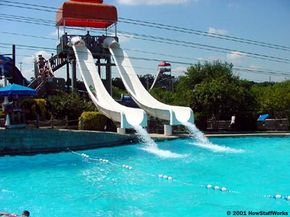The Physics of Falling
At its most basic level, a waterslide is a relatively tame roller coaster with no track and no car. If you've read How Roller Coasters Work, then you know that coaster cars are driven by gravity.
At the beginning of the ride, the coaster car is pulled up the lift hill. As the coaster rises higher in the air, its potential energy, or energy of position, increases. Simply put, it has farther to fall. When the coaster is released at the top of the hill, gravity pulls it down the track, converting potential energy to kinetic energy, or energy of motion.
Advertisement
Waterslides work on exactly the same principle. But instead of a lift hill, you have a stairway. Climbing the stairs builds up a certain amount of potential energy, which turns into kinetic energy as you head down the slide. A taller slide has more potential energy to work with than a shorter slide.
On a waterslide, your body, sometimes combined with a mat or raft, takes the place of the roller coaster car. Coaster cars have wheels that roll along the track. This reduces the friction between the car and the track, so the car can keep moving. Waterslides have a constant stream of water flowing from the top to the bottom. The water lubricates the slide to reduce the friction between the slide and your body.
Apart from total height, the main difference between particular waterslides is the way they put the potential energy to work. This is determined by the shape of the slide. We'll look at how a slide's shape affects how fast you fly and how far you move in the next section.
